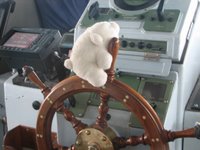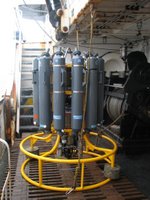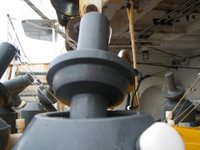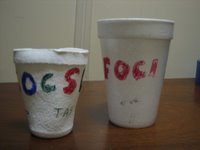Sunday, May 27, 2007
Final Day of the Survey
NOAA Teacher At Sea: Jacob Tanenbaum
Mission: Fisheries Oceanography Coordinated Investigations
Day 9: May 27, 2007
Weather Data from the Bridge:
Visibility: 10 Miles
Wind Speed: 20 Kts.
Sea Wave Height: 2
Sea Wave Height: 2
Water Temperature: 4.7 Degrees Celsius
Air Temperature: 6 Degrees Celsius
Pressure: 1010.7 Mbs

Personal Log
We reach Kodiak in the morning. I am excited to be seeing Kodiak, but sad to be leaving the ship. It has been a wonderful 10 days at sea. Please check back tomorrow. I should be able to do a blog entry from the hotel in Kodiak and I can show you this incredible island. My heartfelt thanks to everyone on the ship who gave me such a wonderful welcome and who gave such support to this project.
Here are a few last photos from around the ship: Snuggy in the Captains chair and Snuggy at the wheel of the ship.
Science Log:
Today was an important part of the cruise. On section, in addition to the bongo nets, we also deployed an instrument called a CTD array. This array allows the scientists to sample water at different depths. This is very important in oceanography because the water lower down is very different from the
bongo nets, we also deployed an instrument called a CTD array. This array allows the scientists to sample water at different depths. This is very important in oceanography because the water lower down is very different from the  water higher up in the water column. The chemistry changes as you go down, the temperature changes and the creatures living at each depth may be different from the creatures above or below. Want to learn more about this important research? Click here for a video. We also stopped to have some fun with the CTD. We attached some Styrofoam cups to the array and watched what happens when the pressure at depth presses in on them. Click here for a video.
water higher up in the water column. The chemistry changes as you go down, the temperature changes and the creatures living at each depth may be different from the creatures above or below. Want to learn more about this important research? Click here for a video. We also stopped to have some fun with the CTD. We attached some Styrofoam cups to the array and watched what happens when the pressure at depth presses in on them. Click here for a video.
We are coming to the end of the cruise now. We deployed the bongos 125 times and have done 8 CTD’s, and released one drifter buoy. The scientists had wanted to do more. They had planed 169 bongo deployments, but the bad weather forced us to change our plans. “That is the way things go out here,” says Chief Scientist Annette Dougherty. Lets talk to her more about what we have learned so far on this cruise:

Tell us what you have learned so far:
On the standardized grid we have been doing, the numbers of Pollock are low, but spread out across the grid. The fish are also small. 4.5 to 6.5 mm. Which is considerably smaller than last year.
What does that mean?
It is a colder year and a very turbulent year, with a lot of storms, and what that can do is flush things out through the strait we are sailing in. The fish may have spawned late. Or we could be catching the end of the hatching. It is hard to predict how many Pollock return as spawners if you can’t be out here all the time.
So what does the survey tell us?
This is a colder year, and the growth rate has been slow. They are eating, so it does not mean they will not survive. There is a lot of stuff out there.
The study mainly tells us about the early life history. About what the fish goes through from hatch to spawning. The egg is the strongest stage these fish have. After they hatch, they have a short time to use their yolk sack before they have to start to feed. If they can learn to feed! Some fish are stupid and they can’t figure that out and just die. Most figure it out because they have to grow. There is mortality around every corner for these fish. They flow with this current stream – well what if there is not food where it takes them? What if they don’t develop as fast as the fish up stream? They will be competing for the same food. There is a lot against these fish, and they manage to survive. Females produce thousands of eggs, but very few survive. There are a lot of hungry mouths out there!
What happens next in the study:
The database that we have been entering numbers into will go into a centralized database. I will also build a cruise report from that. It will state general numbers and what grid stations they occupied. The numbers that we put in are preliminary estimates of the population. We wait until the samples come back from Poland. They will be very meticulously sorted. Those final numbers are what we use for larval abundance (the number of Pollock babies).
How many years has this study been going on?
The study has been going on for 21 years now.
What have you learned in that time?
It is amazing how much things vary from year to year. It is hard to predict, based on a few environmental variables what will happen to these fish. You have to have patience. This could be a good recruitment year. We could have missed them.
When will you know for sure if it was a strong year?
We will have to wait for 3 to 4 years to decide how many will spawn. Next year in the March survey, we will be able to see how many we catch as one-year-olds. They go through their first year, which is very hard for them.
What is next for you?
I have a whole lot of odoliths (ear-bone samples) to read from another survey. I come back in September with Mat Wilson to see these same fish as what we call age-zero. They do a lot of growing between now and then. They don’t have a vertebra right now. They can’t swim against the current yet. At about 12 millimeters, they will begin to grow bones. That is the beginning of juvenal transformation. They will look like miniature adults in September. They are a beautiful golden bronze.
Personal Log
We reach Kodiak in the morning. I am excited to be seeing Kodiak, but sad to be leaving the ship. It has been a wonderful 10 days at sea. Please check back tomorrow. I should be able to do a blog entry from the hotel in Kodiak and I can show you this incredible island. My heartfelt thanks to everyone on the ship who gave me such a wonderful welcome and who gave such support to this project.
Here are a few last photos from around the ship: Snuggy in the Captains chair and Snuggy at the wheel of the ship.
Science Log:
Today was an important part of the cruise. On section, in addition to the
We are coming to the end of the cruise now. We deployed the bongos 125 times and have done 8 CTD’s, and released one drifter buoy. The scientists had wanted to do more. They had planed 169 bongo deployments, but the bad weather forced us to change our plans. “That is the way things go out here,” says Chief Scientist Annette Dougherty. Lets talk to her more about what we have learned so far on this cruise:
Tell us what you have learned so far:
On the standardized grid we have been doing, the numbers of Pollock are low, but spread out across the grid. The fish are also small. 4.5 to 6.5 mm. Which is considerably smaller than last year.
What does that mean?
It is a colder year and a very turbulent year, with a lot of storms, and what that can do is flush things out through the strait we are sailing in. The fish may have spawned late. Or we could be catching the end of the hatching. It is hard to predict how many Pollock return as spawners if you can’t be out here all the time.
So what does the survey tell us?
This is a colder year, and the growth rate has been slow. They are eating, so it does not mean they will not survive. There is a lot of stuff out there.
The study mainly tells us about the early life history. About what the fish goes through from hatch to spawning. The egg is the strongest stage these fish have. After they hatch, they have a short time to use their yolk sack before they have to start to feed. If they can learn to feed! Some fish are stupid and they can’t figure that out and just die. Most figure it out because they have to grow. There is mortality around every corner for these fish. They flow with this current stream – well what if there is not food where it takes them? What if they don’t develop as fast as the fish up stream? They will be competing for the same food. There is a lot against these fish, and they manage to survive. Females produce thousands of eggs, but very few survive. There are a lot of hungry mouths out there!
What happens next in the study:
The database that we have been entering numbers into will go into a centralized database. I will also build a cruise report from that. It will state general numbers and what grid stations they occupied. The numbers that we put in are preliminary estimates of the population. We wait until the samples come back from Poland. They will be very meticulously sorted. Those final numbers are what we use for larval abundance (the number of Pollock babies).
How many years has this study been going on?
The study has been going on for 21 years now.
What have you learned in that time?
It is amazing how much things vary from year to year. It is hard to predict, based on a few environmental variables what will happen to these fish. You have to have patience. This could be a good recruitment year. We could have missed them.
When will you know for sure if it was a strong year?
We will have to wait for 3 to 4 years to decide how many will spawn. Next year in the March survey, we will be able to see how many we catch as one-year-olds. They go through their first year, which is very hard for them.
What is next for you?
I have a whole lot of odoliths (ear-bone samples) to read from another survey. I come back in September with Mat Wilson to see these same fish as what we call age-zero. They do a lot of growing between now and then. They don’t have a vertebra right now. They can’t swim against the current yet. At about 12 millimeters, they will begin to grow bones. That is the beginning of juvenal transformation. They will look like miniature adults in September. They are a beautiful golden bronze.
Comments:
<< Home
Hi Jacob,
It's Zack. I found this extremely interesting. I am glad the videos work this year. When I saw the video of the ship, I was amazed to see how big it is. I thought the lounge looked. My mom wants to know if the big chairs and sofas are bolted down. Living in earthquake country makes you think about that.
When I watched the video about the styrofoam cups, I thought the cups would come back with dents, or crushed. I was surprised to see that the cups came back completely inporportion, but smaller.
I hope you had a great trip. See you this summer!
Zack
It's Zack. I found this extremely interesting. I am glad the videos work this year. When I saw the video of the ship, I was amazed to see how big it is. I thought the lounge looked. My mom wants to know if the big chairs and sofas are bolted down. Living in earthquake country makes you think about that.
When I watched the video about the styrofoam cups, I thought the cups would come back with dents, or crushed. I was surprised to see that the cups came back completely inporportion, but smaller.
I hope you had a great trip. See you this summer!
Zack
hey Mr.T,
What's up? We hope you are having a great time in Alaska. While you were on your trip we have learned many things. We found out that plankton is very very VERY important. That is just some of the things we learned!
From,
your students
What's up? We hope you are having a great time in Alaska. While you were on your trip we have learned many things. We found out that plankton is very very VERY important. That is just some of the things we learned!
From,
your students
dear mr.t,
i learned that you were studing the larvae of Pollock. Pollock is fished very heavily and we need to understand ways to help it. And i would love to go to Jamaca. i would like to Jamaca because i think their culture.Also i hope you come back safely!
i learned that you were studing the larvae of Pollock. Pollock is fished very heavily and we need to understand ways to help it. And i would love to go to Jamaca. i would like to Jamaca because i think their culture.Also i hope you come back safely!
hello Mr. tanumbaum i thought about you going to Alaska and thought that i would like to go to Antarctica to study penguin, fish, and ice.
i learned that plankton are either animal{zoo plankton}{Pollock} or plant and the plant type eat the sunlight
i learned that plankton are either animal{zoo plankton}{Pollock} or plant and the plant type eat the sunlight
thankyou for gonig to the sea and testing to see all the grate things.seeing you go to Alaska insperd me to woun't to go to the north pole.
Dear Mr.T,
Hello, how are you,I hope you are having a great time. I learned that there are 2 kinds of plankton, plant plankton, and zooplankton. If I could go anywhere I would go to Califonia because it is warm there. I hope you have a great trip home.
Hello, how are you,I hope you are having a great time. I learned that there are 2 kinds of plankton, plant plankton, and zooplankton. If I could go anywhere I would go to Califonia because it is warm there. I hope you have a great trip home.
heyy mr. t How are you? i hope you had a good trip! i am soo glad that you got involved with aninmals!
hello there
how are you doing?
i hope you will come back to the school safe
are you finding alot of new stuf
sense you been there
well thats it
have a safe trip
bye
how are you doing?
i hope you will come back to the school safe
are you finding alot of new stuf
sense you been there
well thats it
have a safe trip
bye
Dear Mrs. T.
hello how are you doing I hope you have a good trip back. Thank you for teaching us about planten. i hear you lunched the dritter bouy was it fun and i am looking foward to seeing you on thursday.
From, Jacquelyn
hello how are you doing I hope you have a good trip back. Thank you for teaching us about planten. i hear you lunched the dritter bouy was it fun and i am looking foward to seeing you on thursday.
From, Jacquelyn
Dear Mr T,
Greetings from state New York. How ya doing? Seems cool how you can measure the tempature using the drifter bouy. Thanks for teaching us about plankton. Hope you come home saftly. If I can go anywhere in the world I would go to Russia.
From Emily
Greetings from state New York. How ya doing? Seems cool how you can measure the tempature using the drifter bouy. Thanks for teaching us about plankton. Hope you come home saftly. If I can go anywhere in the world I would go to Russia.
From Emily
Dear Mr.T,
I hope you have a good and safe trip back home. That was one trip. I hoped you liked it. One place I would like to go is Greenland. Isn't it ice there? Oh well. I'm lokking foward for you coming back. We already learned about about the echosystem so we knew exactly what you were talking about.
I hope you have a good and safe trip back home. That was one trip. I hoped you liked it. One place I would like to go is Greenland. Isn't it ice there? Oh well. I'm lokking foward for you coming back. We already learned about about the echosystem so we knew exactly what you were talking about.
dear mr. T.
i'm so glad you're coming back!!!! i hope you don't get stuck again.
if i could go any place in the world i would like to go to Italy or Alaska.
i'm so glad you're coming back!!!! i hope you don't get stuck again.
if i could go any place in the world i would like to go to Italy or Alaska.
Dear Mr T,
hello how are you doing i hope you had a fun trip. I hope you had a fun trip I heard you are coming back on Thursday. Thank you for taking the time to teach us about planten. If I can go anywhere in the world I will go to California because my dad lives there and I go out there every summer and I one's lived there. From,Jacquelyn
hello how are you doing i hope you had a fun trip. I hope you had a fun trip I heard you are coming back on Thursday. Thank you for taking the time to teach us about planten. If I can go anywhere in the world I will go to California because my dad lives there and I go out there every summer and I one's lived there. From,Jacquelyn
Dear Mr.Tanenbaum,
Hi nice to see you! I did not know that plankton was so important. If I went anywhere I would go to Austrialia because I really like koalas anmd kangaroos.
Post a Comment
Hi nice to see you! I did not know that plankton was so important. If I went anywhere I would go to Austrialia because I really like koalas anmd kangaroos.
<< Home









